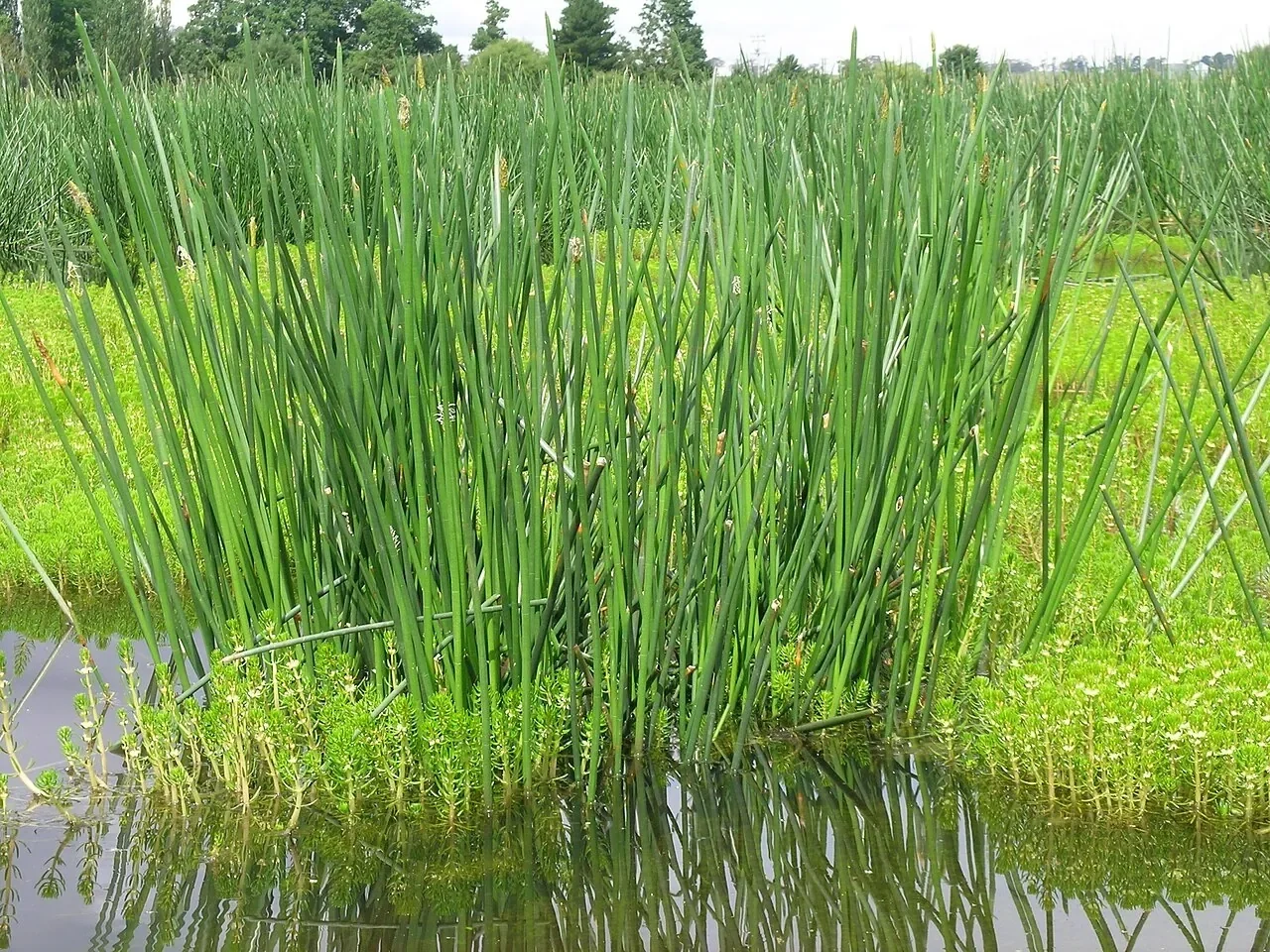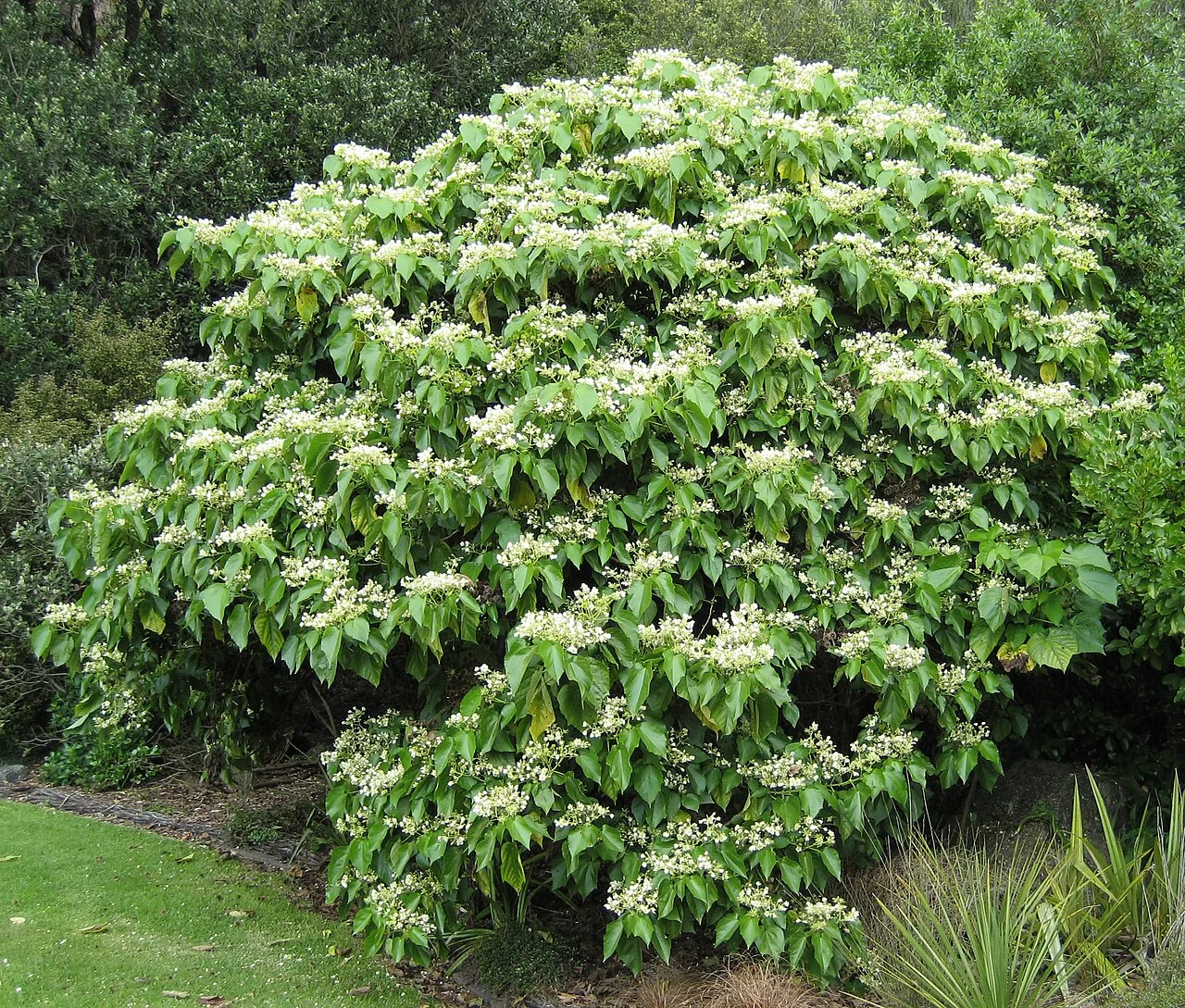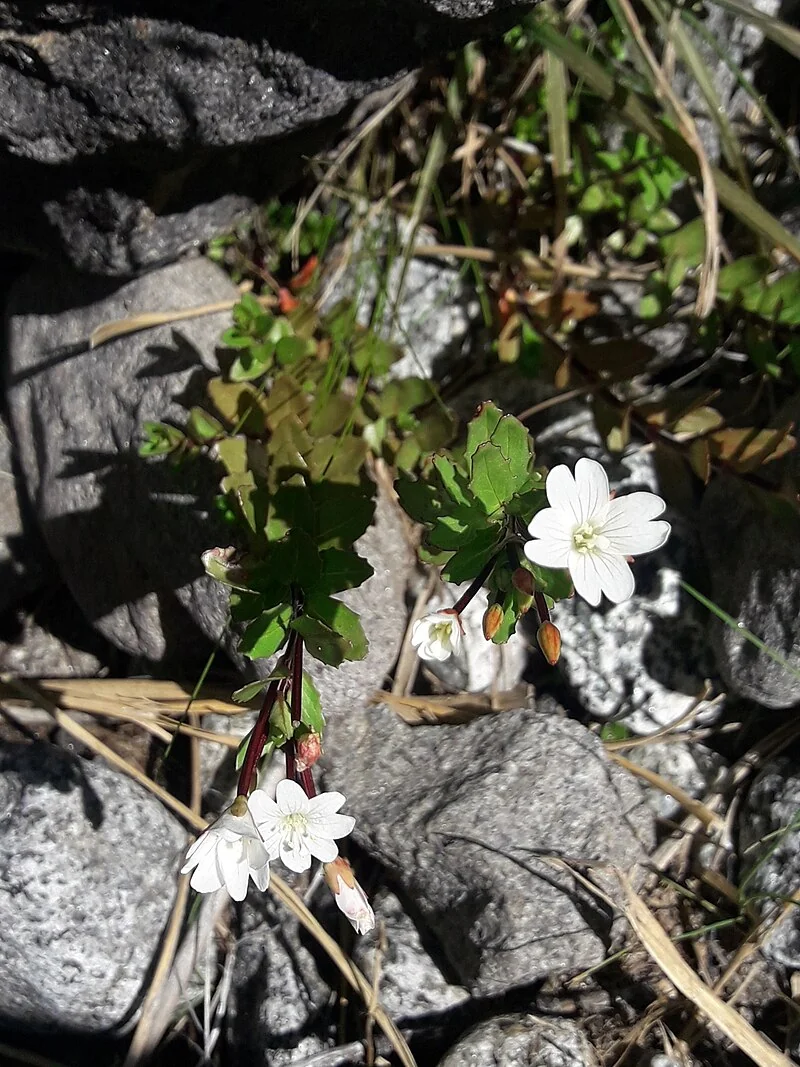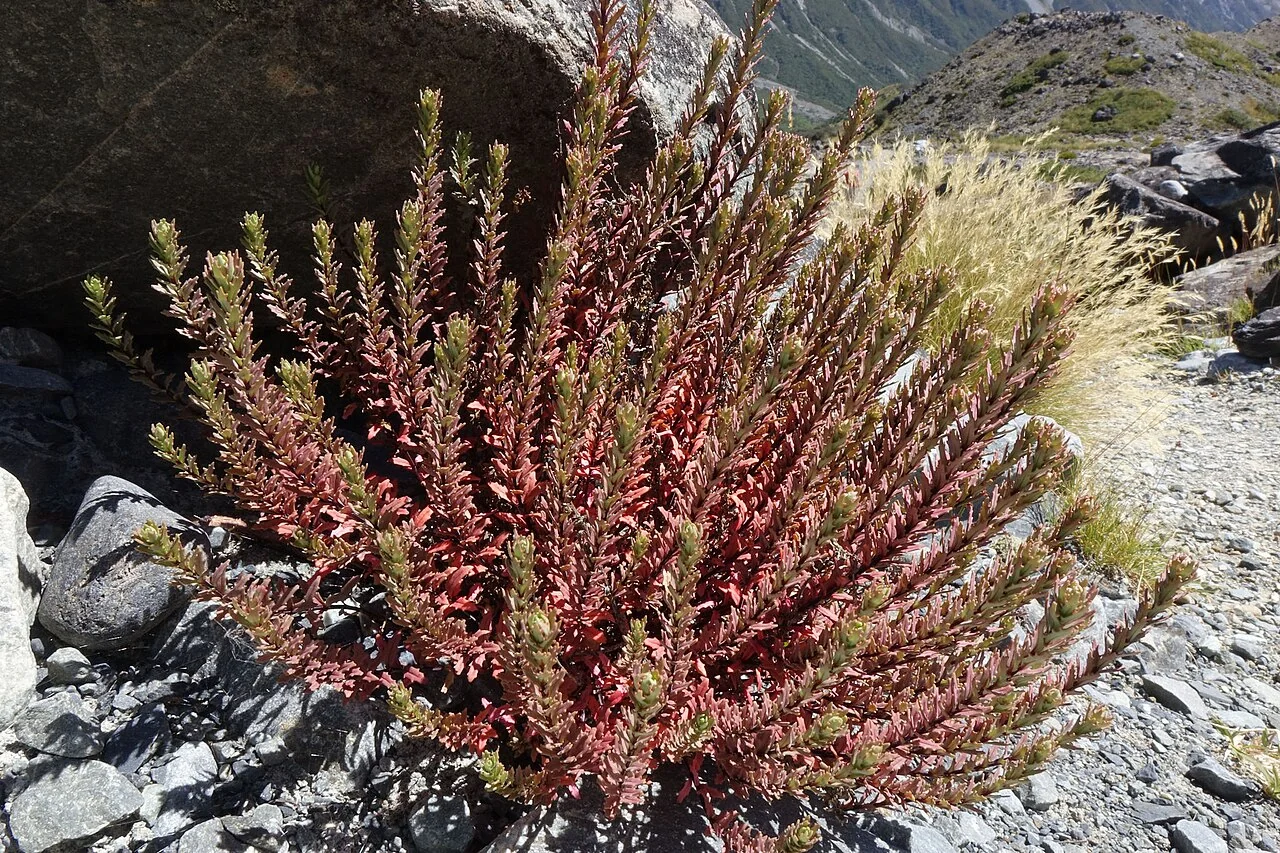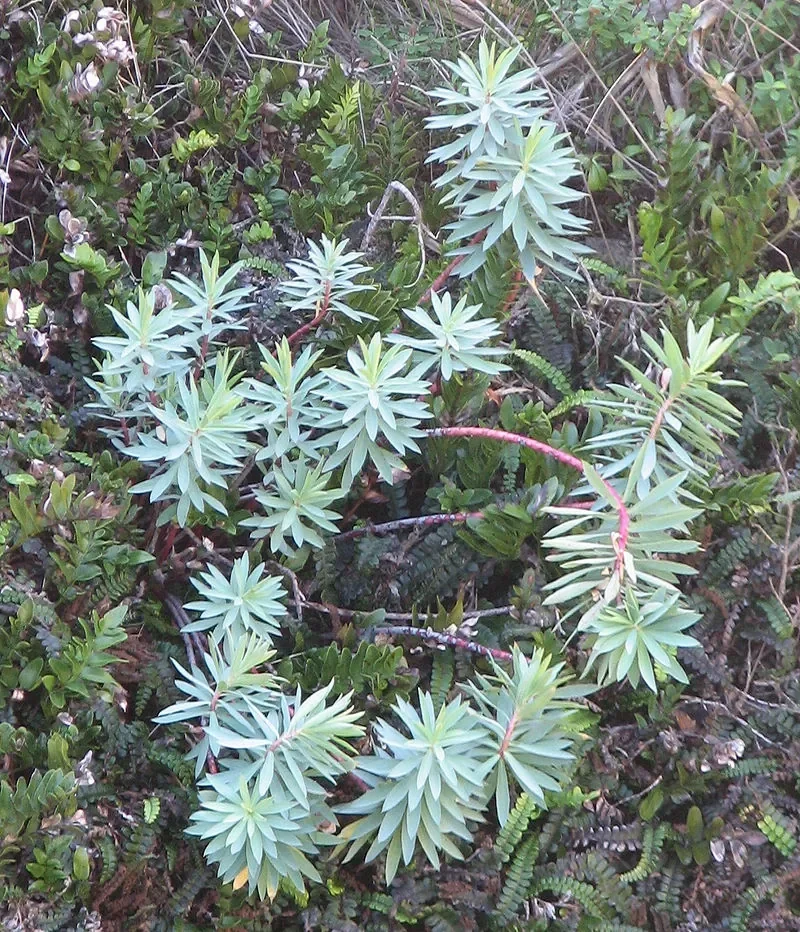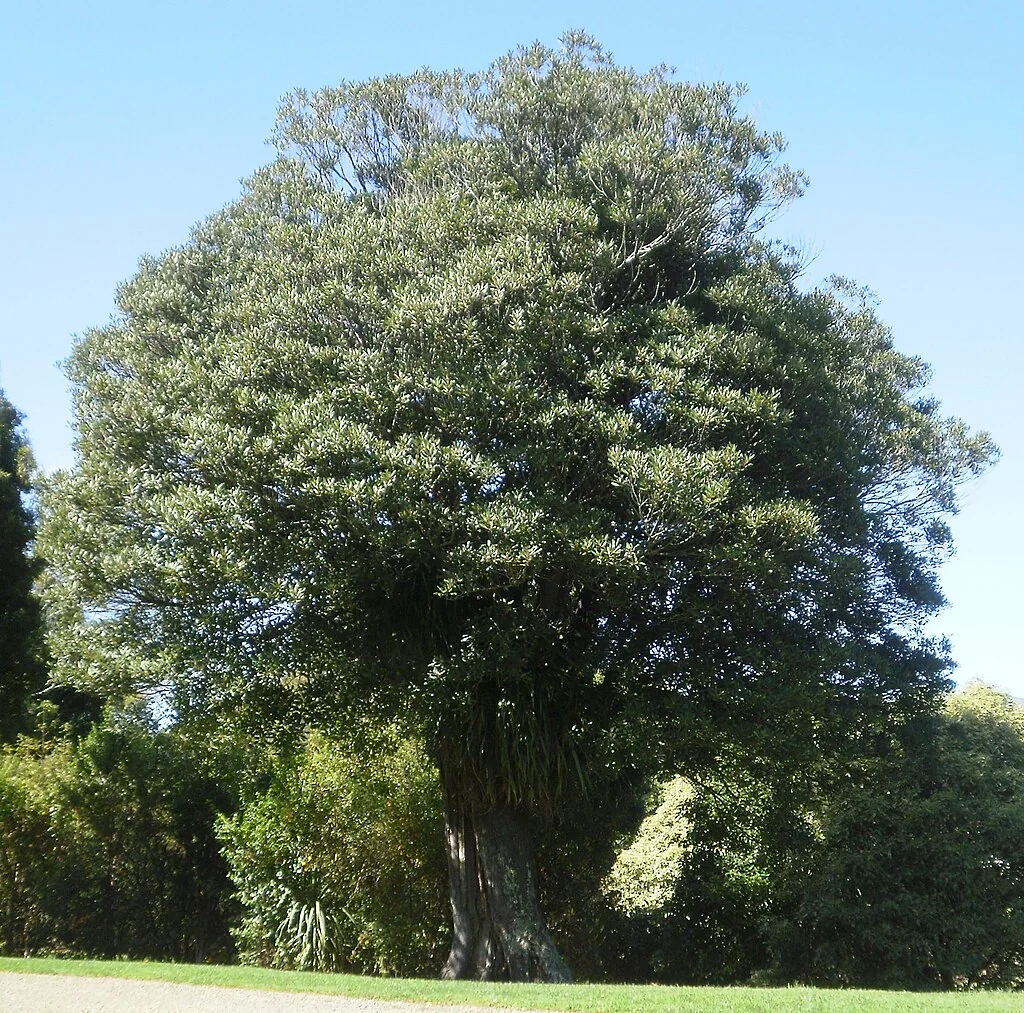
Hānau
Elaeocarpus dentatus
Hānau (Elaeocarpus dentatus) stands as one of New Zealand's most elegant and culturally significant native trees, gracing lowland and montane forests with its distinctive bicolored foliage and cascading displays of lily-like white flowers that transform the canopy into a fragrant wonderland each spring. This magnificent evergreen can reach heights of 20 meters with broad, spreading crowns that create cathedral-like spaces beneath, while its characteristic leaves - dark green above and silvery-white beneath - create a shimmering, two-toned effect that makes the tree instantly recognizable even from a distance. The tree's scientific name "dentatus" perfectly captures one of its most distinctive features: the beautifully serrated leaf edges that give each leaf an intricate, saw-toothed outline, while small pit-like structures called domatia on the leaf undersides provide homes for beneficial mites that help protect the tree from harmful insects. From October through February, Hānau produces spectacular floral displays with long, drooping racemes of small white flowers that bear a striking resemblance to lily of the valley, filling the forest with sweet fragrance while attracting numerous native insects and birds. The tree's purple-black berries, which follow the flowers and ripen from December to May, held enormous cultural importance for Māori communities who developed sophisticated techniques for processing the fruit into nutritious cakes, involving careful soaking, rubbing, and sieving before baking - a testament to the deep botanical knowledge that sustained indigenous populations for generations. Beyond its cultural significance, Hānau plays crucial ecological roles in New Zealand's forest ecosystems, with its berries providing essential food for native birds including kererā, tāā, and bellbirds, whose feeding activities help maintain forest connectivity through seed dispersal. The tree's strong, dark heartwood has practical applications, being valued for its durability in construction and fencing, while its broad canopy provides vital habitat for epiphytes, small mammals, and nesting birds. In modern landscape settings, Hānau offers exceptional ornamental value with its year-round foliage interest, seasonal flowering spectacle, and wildlife attraction capabilities, making it an outstanding choice for large gardens, parks, and restoration projects where its majestic presence can be fully appreciated.

Plant Description
Botanical Features
Hānau (Elaeocarpus dentatus) is a medium-sized evergreen tree endemic to New Zealand, typically growing up to 18-20 meters tall, with a broad, spreading crown and a trunk that can reach 1 meter in diameter. Its distinctive features include leathery, bicolored leaves that are dark green on top and off-white and silky-hairy underneath, with slightly toothed (serrated) margins and often small pits (domatia) on the underside. From October to February, the tree produces conspicuous sprays of drooping, white, "lily of the valley"-like flowers. These are followed by fleshy, ovoid, purple-black drupes (fruit) that are 12-18 mm long, ripening from December to May. These fruits are attractive to birds and were historically an important food source for Māori. Hānau prefers rich, moist, well-drained soil and can grow in partial shade. Its heartwood is dark brown, heavy, and strong, traditionally used for fence posts.
Quick Facts
Overview
| Scientific Name | Elaeocarpus dentatus |
|---|---|
| Height | 12-15 m |
| Spread | 6-10 m |
| Water Needs | Moderate |
| Light | Partial shade to full sun |
| Frost Tolerance | Moderate |
| Salt Tolerance | Poor |
| Growth Rate | Moderate |
| Lifespan | Long-lived tree |
Climate Best Suited to
Hnau occupies a wide climatic range from warm lowlands to cool hill country, provided soils are welldrained and moisture is reliable. It tolerates light frosts inland once established but grows best with shelter and humusrich soils.
Regional Suitability
| City | Climate Suitability |
|---|---|
| Whangārei | Ideal |
| Auckland | Ideal |
| Hamilton | Ideal |
| Tauranga | Ideal |
| Rotorua | Ideal |
| Gisborne | Ideal |
| New Plymouth | Ideal |
| Napier | Ideal |
| Whanganui | Ideal |
| Palmerston North | Ideal |
| Wellington | Ideal |
| Nelson | Ideal |
| Christchurch | Ideal |
| Dunedin | Ideal |
| Invercargill | Ideal |
Natural Habitat
Hānau (Elaeocarpus dentatus) is an evergreen tree native to New Zealand. It is found on both the North and South Islands, extending as far south as Westland in the west and Christchurch in the east.
Its natural habitat includes coastal and lowland forests, occasionally reaching into montane forests. It prefers humid locations with adequate rainfall throughout the year and thrives in most soil types, particularly well-drained soil. In the North Island, it can be found up to 1000 meters altitude, but is more common below 750 meters. In the South Island, it is rare above 50 meters but can grow up to 380 meters. It is moderately frost-hardy.
Plant Conservation
The conservation status of Elaeocarpus dentatus (commonly known as hīnau), a native lowland forest tree of New Zealand, is generally "Not Threatened." This classification applies to the variety Elaeocarpus dentatus var. dentatus, as indicated in conservation status reports from 2013, 2018, and 2024.
However, the variety Elaeocarpus dentatus var. obovatus was listed as "Data Deficient" in a 2017 Department of Conservation Conservation Status Report, and its status requires further investigation.
Growing Requirements
Soil Requirements
Prefers deep, welldrained, fertile forest soils with abundant organic matter. Mulching improves moisture retention and soil life. Avoid compacted or waterlogged sites.
- Moist, freedraining loams with high humus content
- pH slightly acidic to neutral
- Thick organic mulch; keep clear of trunk
Light Requirements
Establishes readily in partial shade under a nurse canopy, then tolerates full sun with shelter. Inland, filtered light reduces leaf scorch during hot, dry winds.
- Partial shade to full sun when sheltered
- Wind shelter improves leaf quality and growth
Water Requirements
Keep evenly moist during establishment. Mature trees cope with short dry periods, but regular deep watering in drought promotes fruiting and canopy health.
- Even moisture first 23 years
- Deep irrigation in extended summer drought
- Avoid prolonged waterlogging
Planting Guide
Hīnau (Elaeocarpus dentatus) is a native New Zealand evergreen tree that can grow up to 18-20 meters tall. It is known for its glossy leaves, white flowers, and purple-black fruits.
1. Location and Sunlight:
- Hīnau prefers full sun to partial shade.
- It thrives in sheltered environments but can tolerate light frost and wind once established.
- In warmer climates, it benefits from morning sunlight and partial afternoon shade to prevent heat stress.
2. Soil:
- Elaeocarpus dentatus prefers fertile, humus-rich, well-drained soil.
- It can grow in light (sandy), medium (loamy), and heavy (clay) soils.
- It prefers moist, lime-free soil and can grow in very acid to neutral pH soils.
- It is found on a wide range of soils, including pumice soils, but in the South Island of New Zealand, it is usually restricted to more fertile sites.
3. Watering:
- Water regularly while the tree is young to help it establish.
- Once established, it becomes relatively drought tolerant.
- It prefers moderate humidity and benefits from natural rainfall.
- Water every 2-3 weeks, allowing the soil to dry slightly between waterings.
- During cooler, dormant seasons, its water needs decrease.
4. Fertilization:
- Fertilizer is rarely needed for established trees.
- For optimal growth, especially in its juvenile stage, apply a balanced nutrition fertilizer from late winter to early spring.
- Use a higher nitrogen formula for young plants every 2-3 months.
- Always water thoroughly after fertilizing to enhance absorption and prevent root burn.
5. Pruning:
- Pruning is seldom required but can be done to remove damaged branches.
- Strategic pruning during its dormant winter period can help remove dead wood, thin branches for airflow, and shape the tree for balance, leading to enhanced health and vigorous growth.
6. Planting:
- Planting in autumn or spring allows roots to establish before seasonal extremes.
- When planting, allow 4 to 6 meters between trees to accommodate their mature spread.
- Mulching around the base will conserve soil moisture and suppress weeds.
7. Hardiness:
- It is hardy to UK zone 9. USDA Hardiness Zone 8b-9.
- It is moderately frost hardy, but in areas with severe frost, it is confined to fertile soils.
Elaeocarpus dentatus is a low-maintenance and dependable tree, suitable for both home gardens and native restoration projects.
Ecological Role
Elaeocarpus dentatus, commonly known as the Hinau Tree, plays several important ecological roles, particularly in its native New Zealand ecosystems.
- Food Source: The tree produces white, bell-shaped flowers and bluish-black, fleshy fruits (drupes) that serve as a significant food source for native birds and insects. The fruit ripens from December to May and is attractive to birds.
- Biodiversity and Ecosystem Resilience: Hinau is considered an important species in revegetation and ecological planting efforts, contributing to the restoration of biodiversity and the resilience of natural habitats.
- Habitat Provision: As a native lowland forest tree, it forms part of the forest structure, providing habitat within these ecosystems.
- Support for Pollinators: Its flowers attract insects, contributing to pollination processes within its environment.
- Honey Production: Elaeocarpus dentatus is recognized as a native forest species that is important for honey production.
Uses and Significance
Flowers provide nectar/pollen for insects; abundant fruits feed kerer2 and other birds, aiding seed dispersal. The evergreen canopy contributes to forest structure and shade.
Cultural and Practical Uses
Hnau bark was traditionally used as a dark dye/tannin source, and the nutritious berries were processed as food in some rohe. Today it is valued in restoration and largesite landscaping for durable canopy and wildlife support.
- Restoration canopy in lowland/montane forests
- Specimen or shelter tree on suitable sites
Landscaping Uses
Elaeocarpus dentatus, commonly known as the Hinau Tree, is a versatile native New Zealand tree with several landscaping applications due to its attractive features and ecological benefits.
Key Landscaping Uses Include:
- Specimen Tree: It is highly valued as a specimen tree, showcasing its attractive form, glossy evergreen foliage, white bell-shaped flowers, and bluish-black fruit.
- Shade and Street Tree: With its broad, spreading crown, it is an excellent choice for providing shade and is suitable for street plantings.
- Background Planting: It can be effectively used in larger gardens and reserves as background planting.
- Ecological and Revegetation Projects: The Hinau tree plays a crucial role in ecological plantings and revegetation efforts, contributing to biodiversity and resilience. Its flowers attract bees and insects, and its fruit provides a food source for native birds.
- Screening and Hedging: Its dense crown makes it suitable for screening and hedging purposes.
- Specific Garden Styles: It is well-suited for coastal, Japanese, and native garden styles.
- Water Features: It can be incorporated into landscapes around ponds and wetlands.
- Riparian Plantings: The tree is also used in riparian plantings along waterways.
Elaeocarpus dentatus is a hardy tree that thrives in full sun to partial shade and well-drained soil, tolerating light frost and wind once established.
Seasonal Care Calendar
Spring
Plant containergrown trees; control weeds and renew mulch. Light formative pruning to remove crossing shoots.
- Planting and staking if windexposed
- Top up organic mulch
Summer
Maintain deep, infrequent watering during dry spells. Inspect for scale/sooty mould where honeydew occurs.
- Deep irrigation in drought
- Weed and mulch to conserve moisture
Autumn
Fruiting season in many regions; collect seed for propagation. Reduce irrigation with cooler weather.
- Seed collection and cleaning
- Light corrective pruning only
Winter
Undertake structural pruning on dry days. Provide frost protection for juveniles in cold districts.
- Sanitation pruning
- Wind/shelter maintenance
Pruning and Maintenance
Techniques and Timing
Minimal pruning is required beyond formative work. Maintain a strong central leader on young trees and remove dead, damaged or rubbing branches. Avoid heavy topping cuts.
- Formative pruning years 15
- Sanitation pruning as needed
How to Grow Hānau
Hānau is a beautiful and culturally significant native tree, highly valued for its elegant form, distinctive bicolored foliage, and cascading white flowers. It is a prominent feature in New Zealand's lowland and montane forests and is a popular choice for larger gardens and restoration projects. While it is a robust tree, successful cultivation requires attention to its specific needs, particularly regarding moisture, shelter, and protection from frost when young. Understanding its propagation methods is key to successfully growing this iconic species.
From Seed
Propagating Hānau from fresh seed is the most common and generally reliable method, though germination can be slow and erratic. Collect the small, purple-black berries when they are fully ripe, typically from December to May. Clean the seeds thoroughly to remove the fleshy pulp, as this can inhibit germination. Sow the fresh seeds in a well-draining seed-raising mix, lightly covering them. Maintain consistent moisture and provide cool, shaded conditions. Germination can take several months to over a year, and the seeds may benefit from a period of cold stratification. Once seedlings have developed a few true leaves, they can be potted into individual containers and grown in a sheltered, frost-free location for their first few years before planting out.
From Cuttings
Propagation of Hānau from cuttings is generally more challenging and less reliable than from seed. Semi-hardwood cuttings can be attempted in late summer or early autumn from healthy, current season's growth. Cuttings should be about 4-6 inches long. Remove the lower leaves and dip the cut end in a rooting hormone. Plant the cuttings into a well-draining, sterile cutting mix, such as a blend of perlite and peat. Maintain high humidity around the cuttings, perhaps by placing them under a plastic dome or in a propagator, and provide bottom heat to encourage root development. Keep the medium consistently moist but not waterlogged. Rooting can be slow and success rates can be low, making this method more suitable for experienced propagators.
Pests and Diseases
Elaeocarpus dentatus, commonly known as Hinau, is generally considered a hardy species.
Pests:
- While it can host several scale insects, these do not appear to significantly affect the tree.
- The sapwood of the Hinau tree is susceptible to attack by the common house borer.
Diseases:
There is no specific information detailing significant diseases that commonly affect Elaeocarpus dentatus.
Cultural Significance
Elaeocarpus dentatus, commonly known as hīnau, holds significant cultural importance, particularly for the Māori people of New Zealand.
For Māori, the Hīnau Tree Was a Versatile and Highly Valued Resource:
- Food Source: The fruit was a crucial food source. It was crushed, mixed with water, and made into cakes cooked in a hāngi (earth oven). The berries were also pounded, sieved, and made into a meal, which was then steamed. Māori even cultivated hīnau in forest groves for its berries.
- Dye: The bark was used to produce a black dye, which could also fix other dyes. This dye was sometimes exported in the early years of European settlement. An exudation from the tree was also employed in the preparation of black tattooing pigment, believed to prevent tattoos from fading.
- Timber: The wood was utilized for various small implements such as canoe bailers, spears, and wedges. Its strong, tough grain made it suitable for wedges, and it was also used to make walking sticks from young saplings.
- Medicinal Uses: A decoction of the bark in hot water was used to cure skin diseases.
- Other Uses: The bark was used to make large bags for preparing raupō pollen for bread, and sometimes for small water vessels.
Early European Settlers Also Found Uses for Hīnau:
- Hardwood: It was used as a general-purpose hardwood. Older trees developed a durable black heartwood, which was used for house piles and posts.
- Timber Industry: More recently, the timber has been used for boat and motor body building, furniture, turnery, and flooring.
Beyond its practical applications, hīnau is considered an important ecological species and a striking addition to landscapes, valued for its attractive foliage, white bell-shaped flowers, and bluish-black fruit, which provides food for native birds. It is also noted for its fire-retardant properties.
Bonus Tip
Hīnau (Elaeocarpus dentatus) has some fascinating botanical quirks! Its leaves feature small pit-like structures called domatia on their undersides. These tiny "houses" provide shelter for beneficial mites, which in turn help protect the tree from harmful insects - a neat example of a symbiotic relationship in nature. Another interesting fact is about its fruit: the purple-black berries are a favorite food for native birds like the kererū, which play a crucial role in dispersing the seeds throughout the forest. This natural partnership ensures the continued spread and regeneration of this beautiful native tree.
